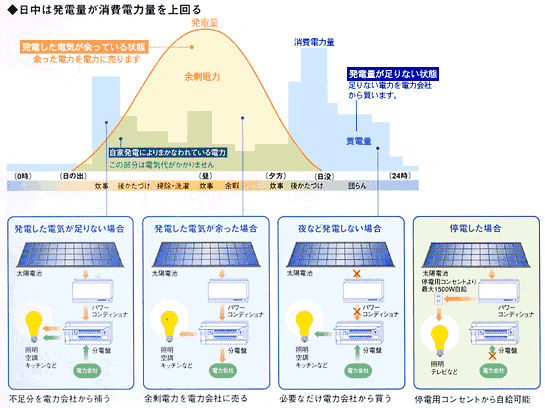|

<<back
|| index || next>>
Photovoltaics
The Facts of the PV market in Japan
Nearly 45% of the world's photovoltaic (PV) solar
cell production is manufactured in Japan.
Japan leads the world in thin film PV with the
highest capacity of operational manufacturing
plants. Present manufacturers are Kyocera, Kaneka,
Matsushita Battery, Sanyo, Sharp and Showa Shell
Sekiyu.
Japan has set a national target to install 300
Megawatts of wind capacity by 2010
(Solarbuzz http://www.solarbuzz.com/FastFactsJapan.htm)
6/24/03
According to NEDO statistics for the International
Energy Agency, the Japanese roof program had promoted
51,899 solar power systems by the end of fiscal
year 2000 (to March 31, 2001).
The capacity of these systems amounts to about
210 megawatts. The maximum output of all such
systems installed in Japan up to this point was
317,5 MW, also according to NEDO.
(The Solarserver http://www.solarserver.de/solarmagazin/artikelseptember2001-e.html)
6/26/03
Why use Photovoltaics?
High Reliability
It operates virtually no maintenance for
long time.
Low Operation cost
PV cells use the energy from sunlight to
produce electricity
It works for fuel free.
Environmental Benefit
Because PV burns no fuel, it does not discharge
carbon dioxide.
PV system is clean and silent.
Modularity
A PV system can be constructed to any size
based on energy requirements.
Low Construction Cost
PV systems are usually placed close to where the
electricity is used, requiring much shorter power
lines than if power is brought in from the utility
grid.
(U.S. Department of Energy http://www.eere.energy.gov/pv/pvmenu.cgi?site=pv&idx=1&body=aboutpv.html)
7/8/03
Demand Stimulation
National government subsidy for installation
covers about 1/2 to 1/3 of equipment and other
costs.
Excess electricity can be sold off to the electric
utility at the same price as electricity supplied.
(NEF -Renewable energy in Japan
http://www.nef.or.jp/english/act06PU01pdf/part01-01.pdf)
7/30/03
World Photovoltaics Production

(Pink = Japan, White = United States,
Yellow = Europe, Green = Others, Line = Total)
Total world installed capacity PV showing that Japan
is fastest growing nation in this sector with growth
rate approximately 20% per year over the last three
years.
(PVTEC http://www.pvtec.or.jp/)
7/23/03
The Leading Solar Quintet: Kyocera, Sharp, Mitsubishi,
Sanyo, Kaneka
Since 2000, the Sharp Corporation has been able to
feel like the world leader, rather than Kyocera. The
company based in Osaka was able to leap from the mid
ranks of solar cell manufacturers to the top within
just two years. "In June of 2001, the second production
line in Shinjo went into operation. The yearly production
capacity is 94 MW," says Hiromi Morita of the Japanese
Sharp headquarters. The volume of sales in the solar
branch should grow around 50 % to 28 billion Yen (about
$ 250 million) this year. Most of the solar cells
will still be sold in the domestic market.
Mitsubishi Electric was number 4 in Japan behind
Sharp, Kyocera, and Sanyo, and this year the electronics
giant plans to expand its capacity to 24 MW.
"Last year Sanyo produced 17 MW in Japan. In the
current fiscal year it should reach 33 MW," says Shijiki
Komatsu of Sanyo . In the long term, Komatsu confirms
that Sanyo would like to build its capacity up to
120 MW. Presently, the company is building a large
solar power plant in the parking lot of the Sanyo
Factory in Gifu, Japan, which with a peak output of
3.4 MW should be the largest in the world. By the
end of March 2002, the installation of one megawatt
is expected.

(The Solarserver http://www.solarserver.de/solarmagazin/artikelseptember2001-e.html)
6/26/03
Market Value of Household Photovoltaics in Japan
 (PVTEC http://www.pvtec.or.jp/englishindex.htm)
8/27/03
(PVTEC http://www.pvtec.or.jp/englishindex.htm)
8/27/03
An Example Installation of Household Photovoltaics

Zîp¾zõdVXe\¬
Zîp¾zõdVXeÍA
E¾zõðdC(¼¬jÉϦé
@u¾zdrW
[v
E»ÌdCðð¬ÉϦÄÆëàÉ
@dÍð·éêûA
@dÍïÐÌzdüÆÌoüèðRg[·é
@up[RfBViv
@
@ÈÇ©ç\¬³êÜ·B
(Agency for Natural Resources
and Energy http://www.pvtec.or.jp/)
7/10/03
Daily Energy Consumption Pattern

(Misawa http://www.misawa.co.jp/C-products/zero-energy/2-souene/index.html)
8/13/03
Average Annual Solar Energy Resources

(NEDO http://www.nedo.go.jp/taiyoshitsu/taiyoko_gaiyo.html)
7/10/03
Annual Expected Japanese Energy Production
Blue bar--Production of Energy from PV per year
(kWh)
Green bar--Conversion of annual energy charge
(Japanese yen)

 > >
Sendai Sapporo


Osaka Tokyo


Naha Hukuoka
(Sharp http://www.sharp.co.jp/sunvista/housing/h_merit/map.html)
7/8/03
Feasibility Study of Photovoltaic Systems in the
Gobi Desert, Mongolia
In the Gobi Desert, Mongolia, the Energy Electronics
Institute of the National Institute of Advanced Science
and Technology (AIST) set up two types of photovoltaic
modules and the checking devices (e.g. I-V Curve Tracer,
etc.) as well as the meteorological monitoring devices
to study the characteristics of the photovoltaic system
operation in the severe natural environment, in corporation
with National University of Mongolia. Purpose of this
study is to verify the output simulation technique
for the vary-large-scale photovoltaic system (VLS-PV)
to confirm the efficiency of using the large scaled
concentrated photovoltaic system to be in this area,
and also to clarify the specification requirement
for the system design. The latest monitoring results
are presented.
dÍGlM[¤å@¾zõdVXeOE
vÍAS§åwÆQNÔ̤¦E
SESr»Ì[ÉÊu·éhmSr§TCVE
hsɨ¢Ä¾zdrW
[Ì^]vªð
Sr»ÍAÛGlM[@ÖiIEAj¾zõdV
Xe¤¦Í¦èiPVPSjɨ¯é^
uåK;zõdVXeÉַ鲸¤vɨE
¢ÄA100MWåK;zõdVXeÌL]ÈóânƵ
»ÌTOÝvâdRXgÌZªsíêÄE
ܸAúËÊÌLx³ðmFµ½B45KÌXÎÊÉ
¨¢ÄPú½ÏÅ5.5kWh/m2ÆÏ
ª³êAâDy̯ú½ÏÌQE
¾zdrÌ¿ÒÔiDCdÊðdreÊŵ½ljE
AP»VRW
[Å5.1ÔA½»VRW
[Å5.2E
±êà̽ÏIÈ3kWVXeÆä×ÄñQ{Å
éB¾zdrÌ·xã¸âêÉNö·éDCLv`¹¸¦Í5
%Å èAàÌáÉεÄÉßĬ³¢±
±ÌVXeø¦ÌdzÍAC·Ìá³i½Ï0.
jÆ̳i½Ï3.47m/sjªe¿µÄ¢éÆl¦E
KØÈp[RfBViðIè·é±ÆÉæ
èASÅÌnAn`¾zõdVXeÍÉE
¢VXeø¦Æå«Èdʪ¾çêéàÌ
NxàϪð±¯é±ÆÅêNðʵÄÌV
Xe]¿ªÂ\ÆÈèAXÉ·úIÉϪðp±·E
±ÆÅASr»Ìµµ¢CÛ«ªA¾zõdVXe̶UE
\É^¦ée¿ioNò»jð]¿·éE
( Technology Development on Performance
and Durability of Photovoltaic Power Generation
Systems http://www.energyelec.aist.go.jp/mongolia/)
10/9/03
Existing Organizations
<<back
|| index || next>>
|





 (PVTEC
(PVTEC 



 >
>


